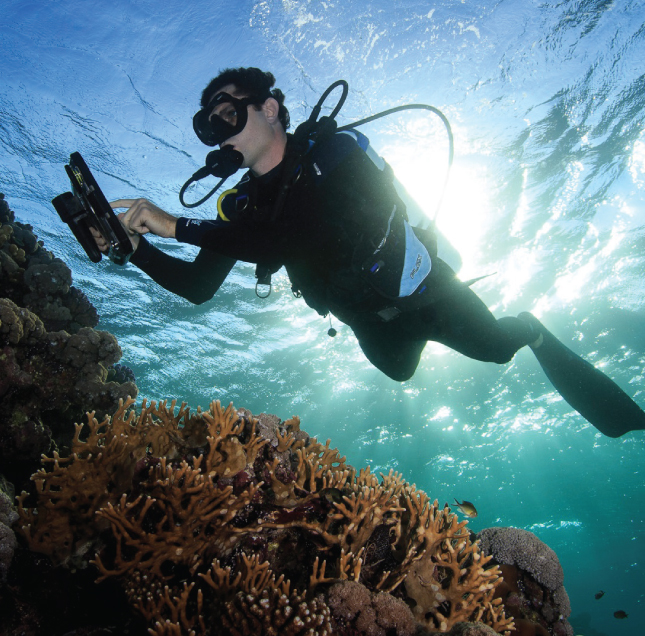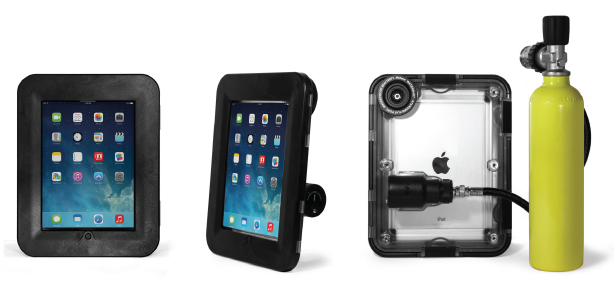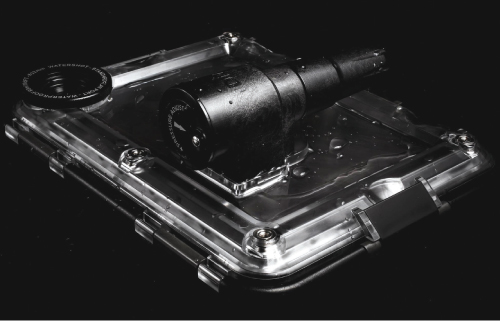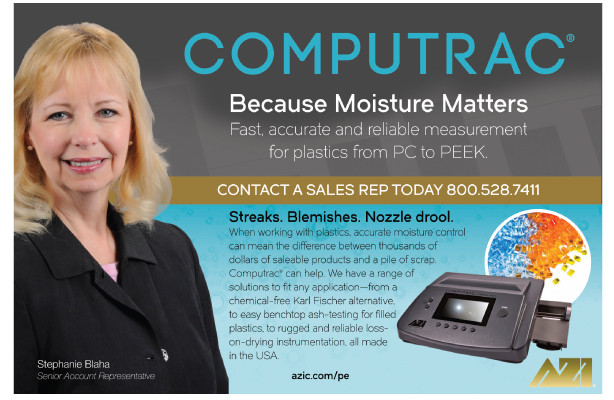By Robert Grace
By Robert Grace
By Robert Grace

The polycarbonate bezel and other components of the iDive housing protect the iPad inside from high water pressures, while still allowing its touchscreen to function (photo courtesy of Tane Sinclair-Taylor).

Front and rear views of the iDive with an iPad inside (at left) and when connected to its pressure balance module (far right).

Front and rear views of the iDive with an iPad inside (at left) and when connected to its pressure balance module (far right).

Eric Larson, Art of Mass Production.

A close-up of the back of an iDive housing.
Apple’s iPads were developed as land-based creatures. Putting them into water creates a whole new set of challenges. Waterproof cases exist to keep them dry under water, but their touchscreens no longer function properly in such conditions.
To simplify his life, Michael Berumen, an American marine biologist working in Saudi Arabia, wanted a solution to that problem. So three years ago he turned to USA-based mechanical engineer Jim Peña and threw down a challenge: “Can you devise a practical means to allow an iPad to work under water, at any depth?”
As part of his job as a professor at King Abdullah University of Science & Technology (KAUST), Berumen did research to uncover new coral, fish, and other species in the reefs of the Red Sea. But he had grown frustrated with the current tools of the trade—manually recording his findings with a special pencil and paper while underwater. Then, back in the lab, he and his team spent many more tedious hours recording the data into spreadsheets. He wanted an underwater digital solution.
Peña, chief engineer and part owner of Watershot Inc. (San Diego, California) and principal of his own consulting firm, Inova Design Inc., pondered the challenge. He called his friend Eric Larson, a mechanical engineer who worked for almost a decade at DuPont Engineering Polymers. Larson had since founded his own material selection consultancy in San Diego, called Art of Mass Production.
Larson, interviewed by phone, recounted the experience. He said his first reaction was, “How hard is that? There are all kinds of waterproof cases, right? But Jim said, ‘No, you don’t understand—the video camera has to work; the touchscreen has to work’.”
Larson soon learned the hard truth: If you put an iPad in a ZipLock bag and take it under water, it’ll be waterproof, but the polyethylene film will stick against the touchscreen, creating a capacitive connection, and the screen won’t recognize your finger anymore.
And so their big adventure began. What transpired next, the 30-year polymer veteran says now, was “easily the most difficult project I’ve ever worked on.”
A Clear Case
They needed to devise a clear, rugged, lightweight, waterproof, pressurized case that would fully function with the iPad’s touchscreen.
Early on, Peña had ideas for how to keep the case’s pressure regulated using a membrane over the touchscreen and a “balance module.” Consider, Larson said, that “if you change 6 inches [or 150 mm of depth] under water, that’s about 2 psi [14 kPa] of pressure difference. It’s pretty dramatic.… So the aim was to keep the internal and external pressure at a certain finite delta, and try to keep the membrane slightly bowed out … then you can keep the membrane away from the iPad screen.”
The balance module that Peña eventually developed works with 800-psi (5500-kPa) liquid carbon dioxide cartridges or with 100-psi (690-kPa) first-stage regulator air pressure (such as from a scuba tank) as the input. The pressure-adjusting system itself is passive. The module uses input from the CO2 or the compressed air in direct proportion to the ambient water pressure. This automatically protects the device from crushing during a descent and also allows the critical function of bleeding air during a diver’s ascent to the surface.
The final product—which they dubbed the “iDive”—also needed to be to be “neutrally buoyant,” meaning the specific gravity of the entire device had to be a little more than 1. Otherwise it would bob up to the surface when you let go of it under water.
KAUST was funding the project for research purposes, and those working on it realized that the end product, even if successful, would likely be made in limited numbers. Still, assuming production volumes would be “in the hundreds” meant they would want to injection mold the eventual housing. The other initial assumption was that polycarbonate would be used for the housing.
The conceptual case consisted of a back housing, a bezel, and a clear, flexible membrane. “We decided early on that we couldn’t get the stiffness we needed with just a plastic bezel,” Larson explained. “The bezel is a perimeter of glass-reinforced polycarbonate—the cross section is kind
of L-shaped—and then there’s an inner frame of die-cast aluminum that’s hard-anodized. That clamps the membrane in place, and then an O-ring seals against the membrane.”
Other design factors came into play. They wanted the iPad logo on the back of the tablet to be visible, as well as the Apple logo. The video camera also had to be fully functional. So this limited where the balance module could be positioned. Additionally, he noted, to carry the name “iDive,” the product had to meet Apple’s high standards and look good with an iPad.
Flexible Membrane Development
In early 2014, the team began seriously exploring the next big challenge—what material to use for the clear membrane. They began by assuming they needed a very thin, rigid sheet—“because a film’s going to puncture, right?” Larson said. They experimented with various thin but stiff sheet materials, including biaxially oriented PET, polycarbonate, and acrylic.
But those just didn’t work. “If a sheet is thin enough, it will be flexible, but it’s not locally elastic.… We realized we needed some amount of local stretching that was 100% recoverable, in a marine environment.” Just getting to that realization took a couple of weeks.
They then began exploring thermoplastic polyurethanes (TPUs). Such materials are very flexible, and fully recoverable within certain elongation, but are not as elastic as latex. After extensive testing, they ended up using an aromatic-based polyether TPU at a thickness of 0.5 mm. The membrane is designed to be replaceable.
Product Launch
Through all this, Watershot, a mechanical engineering consulting and product design company, worked with its long-time, trusted production partner in China, Asia Optical Industries Ltd. The Hong Kong-based company is a molder and contract manufacturer that has a 500-person factory in Shenzhen on China’s mainland. Meanwhile, Taiwan’s Fwu Jih Die Casting Industrial Co. Ltd. started die-casting the aluminum frame and making the precision-machined parts.
The company iDive Inc. launched its case onto the market in August 2014, priced at $799 each. There are now about 600 being used in the field, mostly by marine research centers. The next focus, Larson said, is probably someone like a welder who’s doing work underwater, such as on an oil rig.
When asked, in retrospect, what aspects of this project presented the biggest challenges, Larson stopped a moment to reflect. “You have a clear polycarbonate housing that’s roughly 8 x 11 inches [200 x 280 mm] and 3-mm thick. Then you have a glass-reinforced housing bezel that’s got to fit [tightly]. Then you have a die-cast part you have to fit with that. They all have completely different shrink rates. And the holes have to line up, the O-ring’s got to work, and everything has to be in position for the camera to work. The tolerances alone were a nightmare.”
Additionally, he continued: “Creating something that’s never been done before—that’s hard.… We were two guys working with somebody on the other side of the world, with the testing also being done on the other side of the world, with a global supply chain. Michael [Berumen] had an idea of what he wanted—but he’s not an engineer, he’s a marine biologist. He said, ‘It’s gotta do this. It can’t do that.’ We put that all in a bag, shook it up, and pulled it out—like a magician.”
About the author… A 35-year B2B media veteran, Robert Grace was the founding editor of Crain’s Plastics News in 1989. An ardent design advocate, he left Crain in 2014 to found RC Grace LLC (www.rcgrace.com), a business consultancy that helps companies find business partners and enhance their market presence.


